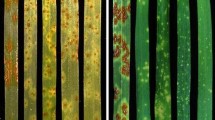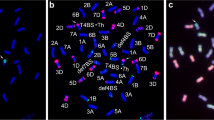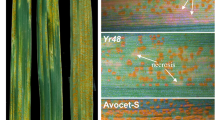Abstract
Stem rust (Puccinia graminis f. sp. tritici Eriks. & E. Henn.) (the causal agent of wheat stem rust) race Ug99 (also designated TTKSK) and its derivatives have defeated several important stem rust resistance genes widely used in wheat (Triticum aestivum L.) production, rendering much of the worldwide wheat acreage susceptible. In order to identify new resistance sources, a large collection of wheat relatives and genetic stocks maintained at the Wheat Genetic and Genomic Resources Center was screened. The results revealed that most accessions of the diploid relative Dasypyrum villosum (L.) Candargy were highly resistant. The screening of a set of wheat–D. villosum chromosome addition lines revealed that the wheat–D. villosum disomic addition line DA6V#3 was moderately resistant to race Ug99. The objective of the present study was to produce and characterize compensating wheat–D. villosum whole arm Robertsonian translocations (RobTs) involving chromosomes 6D of wheat and 6V#3 of D. villosum through the mechanism of centric breakage-fusion. Seven 6V#3-specific EST–STS markers were developed for screening F2 progeny derived from plants double-monosomic for chromosomes 6D and 6V#3. Surprisingly, although 6D was the target chromosome, all recovered RobTs involved chromosome 6A implying a novel mechanism for the origin of RobTs. Homozygous translocations (T6AS·6V#3L and T6AL·6V#3S) with good plant vigor and full fertility were selected from F3 families. A stem rust resistance gene was mapped to the long arm 6V#3L in T6AS·6V#3L and was designated as Sr52. Sr52 is temperature-sensitive and is most effective at 16°C, partially effective at 24°C, and ineffective at 28°C. The T6AS·6V#3L stock is a new source of resistance to Ug99, is cytogenetically stable, and may be useful in wheat improvement.



Similar content being viewed by others
References
Argon-Alcaide L, Miller T, Reader S, Moore G (1996) A cereal centromeric sequence. Chromosoma 105:261–268
Chen PD, Qi LL, Zhou B, Zhang SZ, Liu DJ (1995) Development and molecular cytogenetic analysis of wheat-Haynaldia villosa 6VS/6AL translocation lines specifying resistance to powdery mildew. Theor Appl Genet 91:1125–1128
Chen Q, Conner RL, Laroche A (1996) Molecular characterization of Haynaldia villosa chromatin in wheat lines carrying resistance to wheat curl mite colonization. Theor Appl Genet 93:679–684
Chen PD, Chen SW, Cao AZ, Xing LP, Yang XM, Zhang SZ, Wang XE, Qi LL, Liu DJ (2008) Transferring, mapping, cloning of powdery mildew resistance gene of Haynaldia villosa and its utilization in common wheat. In: Appels R, Eastwood R, Lagudah E, Langridge P, Mackay M, McIntyre L, Sharp P (eds) Proceedings of the 11th international wheat genetics symposium, Sydney University Press, Sydney, p 113
Davies PA, Pallotta MA, Driscoll CJ (1985) Centric fusion between nonhomologous rye chromosomes in wheat. Can J Genet Cytol 27:627–632
Francki MG (2001) Identification of Bilby, a diverged centromeric Ty1-copia retrotransposon family from cereal rye (Secale cereale L.). Genome 44:266–274
Friebe B, Cermeno MC, Zeller FJ (1987) C-banding polymorphism and the analysis of nucleolar activity in Dasypyrum villosum (L.) Candargy, its added chromosomes to hexaploid wheat and the amphiploid Triticum dicoccum–D. villosum. Theor Appl Genet 73:337–342
Friebe B, Jiang J, Raupp WJ, McIntosh RA, Gill BS (1996) Characterization of wheat–alien translocations conferring resistance to diseases and pests: current status. Euphytica 91:59–87
Friebe B, Zhang P, Linc G, Gill BS (2005) Robertsonian translocations in wheat arise by centric misdivision of univalents at anaphase I and rejoining of broken centromeres during interkinesis of meiosis II. Cytogenet Genome Res 109:293–297
Gill BS, Friebe B, Endo TR (1991) Standard karyotype and nomenclature system for description of chromosome bands and structural aberrations in wheat (Triticum aestivum). Genome 34:830–839
Gill BS, Friebe B, Raupp WJ, Wilson DL, Cox TS, Brown-Guedira GL, Sears RS, Fritz AK (2006) Wheat Genetics Resource Center: the first 25 years. Adv Agron 85:73–135
Jiang J, Nasuda S, Dong F, Scherrer CW, Woo SS, Wing RA, Gill BS, Ward DC (1996) A conserved repetitive DNA element located in the centromeres of cereal chromosomes. Proc Natl Acad Sci USA 93:14210–14213
Jin Y, Singh RP, Ward RW, Wangyera R, Kinyua M, Njau P, Fetch T, Pretorius ZA, Yahyaoui A (2007) Characterization of seedling infection types and adult plant infection responses of monogenic Sr gene lines to race TTKS of Puccinia graminis f. sp. tritici. Plant Dis 91:1096–1099
Jin Y, Szabo LJ, Pretorius ZA, Singh RP, Ward R, TJr Fetch (2008) Detection of virulence to resistance gene Sr24 within the TTKS race lineage of Puccinia graminis f. sp. tritici. Plant Dis 92:923–926
Jin Y, Szabo LJ, Rouse MN, TJr Fetch, Pretorius ZA, Wanyera R, Njau P (2009) Detection of virulence to resistance gene Sr36 within the TTKS race lineage of Puccinia graminis f. sp. tritici. Plant Dis 93:367–370
Lukaszewski AJ (1993) Reconstruction in wheat of complete chromosomes 1B and 1R from the 1RS.1BL translocation of ‘Kavkas’ origin. Genome 36:821–882
Lukaszewski AJ (1994) Manipulation of the genome by chromosome breakage. In: Gill BS, Raupp WJ (eds) Proceedings of the US–Japan symposium on the plant classical and molecular cytogenetic analysis, March 1994, Manhattan, pp 136–139, 21–23
Lukaszewski AJ (1997) Further manipulation by centric misdivision of the 1RS.1BL translocation in wheat. Euphytica 94:257–261
Lukaszewski AJ, Gustafson JP (1983) Translocations and modifications of chromosomes in triticale × wheat hybrids. Theor Appl Genet 64:239–248
McIntosh RA, Wellings CR, Park RF (1995) Wheat rusts: an atlas of resistance genes. CSIRO Publishing, Melbourne
Mettin D, Blüthner WD, Schlegel R (1973) Additional evidence on spontaneous 1B/1R wheat-rye substitutions and translocations. In: Sears ER, Sears LMS (eds) Proceedings of the 4th international wheat genetics symposium, Missouri Agricultural Experiment Station, Columbia, pp 179–184
Miller JT, Dong F, Jackson SA, Song J, Jiang J (1998) Retrotransposon-related DNA sequences in the centromere of grass chromosomes. Genetics 150:1615–1623
Murray TD, De La Pena RC, Yildirim A, Jones SS (1994) A new source of resistance to Pseudocercosporella herpotrichoides, cause of eyespot disease of wheat, located on chromosome 4V of Dasypyrum villosum. Plant Breed 113:281–286
Person (1956) Some aspects of monosomic wheat breeding. Can J Bot 34:60–70
Pumphrey MO, Jin Y, Rouse M, Qi LL, Friebe B, Gill BS (2008) Resistance to stem sust race TTKS in wheat relative Haynaldia villosa. In: Appels R, Eastwood R, Lagudah E, Langridge P, Mackay M, McIntyre L, Sharp P (eds) Proceedings of the 11th international wheat genetics symposium. Sydney University Press, Sydney, p 151
Qi LL, Chen PD, Liu DJ, Zhou B, Zhang SZ, et al. (1993) Development of translocation lines of Triticum aestivum with powdery mildew resistance introduced from Haynaldia villosa. In: Li ZS, Xin ZY (eds) Proceedings of the 8th international wheat genetics symposium. Chinese Agricultural Scientech Press, Beijing, pp 333–337
Qi LL, Echalier B, Friebe B, Gill BS (2003) Molecular characterization of a set of wheat deletion stocks for using in chromosome bin mapping of ESTs. Funct Integr Genomics 3:39–55
Qi LL, Friebe B, Zhang P, Gill BS (2007) Homoeologous recombination, chromosome engineering and crop improvement. Chromosom Res 15:3–19
Qi LL, Pumphrey MO, Friebe B, Chen PD, Gill BS (2008) Molecular cytogenetic characterization of alien introgressions with gene Fhb3 for resistance to Fusarium head blight disease of wheat. Theor Appl Genet 117:1155–1166
Rayburn AL, Gill BS (1986) Isolation of a D-genome specific repeated DNA sequence from Aegilops squarrosa. Plant Mol Biol Rep 4:102–109
Röder MS, Korzum V, Wendehake K, Plaschke J, Tixier M-H, Leroy P, Ganal M (1998) A microsatellite map of wheat. Genetics 149:2007–2023
Roelfs AP, Martens JW (1988) An international system of nomenclature for Puccinia graminis f. sp. tritici. Phytopathology 78:526–533
Rozen S, Skaletsky HJ (2000) Primer3 on the WWW for general users and for biologist programmers. In: Krawetz S, Misener S (eds) Methods and protocols: methods in molecular biology. Bioinformatics Humana Press, Totowa, pp 365–386
Sears ER (1952a) Homoeologous chromosomes in Triticum aestivum. Genetics 37:624
Sears ER (1952b) Misdivision of univalents in common wheat. Chromosoma 4:535–550
Sears ER (1954) The aneuploids of common wheat. Res Bull Univ Mo Agric Expt Stn 572:1–58
Sears ER (1966) Nullisomic–tetrasomic combinations in hexaploid wheat. In: Riley R, Lewis KR (eds) Chromosome manipulations and plant genetics. Oliver and Boyd, Edinburgh, pp 29–45
Sears ER, Sears LMS (1978) The telocentric chromosomes of common wheat. Ramanujam S (ed) Proceedings of the 5th international wheat genetics symposium, New Delhi, pp 389–407
Singh RP, Hodson DP, Huerta-Espino J, Jin Y, Njau P, Wanyera R, Herrera-Foessel SA, Ward RW (2008) Will stem rust destroy the world’s wheat crop? Adv Agron 98:271–309
Yildirim A, Jones SS, Murray TD (1998) Mapping a gene conferring resistance to Pseudocercosporella herpotrichoides on chromosome 4V of Dasypyrum villosum in a wheat background. Genome 41:1–6
Zeller FJ (1973) 1B/1R wheat-rye chromosome substitutions and translocations. In: Sears ER, Sears LMS (eds) Proceedings of the 4th international wheat genetics symposium. Missouri Agricultural Experiment Station, Columbia, pp 209–222
Zhang P, Friebe B, Lukaszewski AJ, Gill BS (2001) The centromere structure of Robertsonian wheat-rye translocation chromosomes indicates that centric breakage-fusion can occur at different positions within the primary constriction. Chromosoma 110:335–344
Zhang QP, Li Q, Wang XE, Wang HY, Lang SP et al (2005) Development and characterization of a Triticum aestivum–Haynaldia villosa translocation line T4VS·4DL conferring resistance to wheat spindle streak mosaic virus. Euphytica 145:317–320
Zhang P, Li WL, Friebe B, Gill BS (2008) The origin of a “zebra” chromosome in wheat suggests nonhomologous recombination as a novel mechanism for new chromosome evolution and step changes in chromosome number. Genetics 179:1169–1177
Acknowledgments
We thank Drs. Brady Vick and Steven S. Xu for critical review of the manuscript, W. John Raupp for editorial assistance with the manuscript, and Duane L. Wilson for excellent technical help. This research was supported by grants from the Kansas Wheat Commission, the Kansas Crop Improvement Association, a special USDA-CSREES grant to the Wheat Genetic and Genomic Resources Center, and a grant from Cornell University Project “Durable Rust Resistance in Wheat”. This paper is contribution number 11-166-J from the Kansas Agricultural Experiment Station, Kansas State University, Manhattan, KS 66506-5502.
Author information
Authors and Affiliations
Corresponding author
Additional information
Communicated by P. Langridge.
Rights and permissions
About this article
Cite this article
Qi, L.L., Pumphrey, M.O., Friebe, B. et al. A novel Robertsonian translocation event leads to transfer of a stem rust resistance gene (Sr52) effective against race Ug99 from Dasypyrum villosum into bread wheat. Theor Appl Genet 123, 159–167 (2011). https://doi.org/10.1007/s00122-011-1574-z
Received:
Accepted:
Published:
Issue Date:
DOI: https://doi.org/10.1007/s00122-011-1574-z




